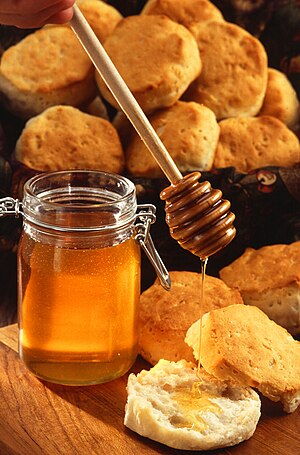 Image via WikipediaThis is a sure sweet thing!
Image via WikipediaThis is a sure sweet thing!-----
By Paul Jobin
Tuesday Apr 19, 2011
If there's one thing most of us have in common it's a story about being stung by a pesky bee.
Mine involved chasing a rampant bull terrier, which had my favourite gumboot well lodged in his jaw, past a stack of beehives. Then there was the time I fetched a flying frisbee that had thumped a hive in the long grass.
New Zealand has some 300,000 beehives, home to honey bees that live for only six weeks but manage, in that time, to fly about 800km. And did you know that bees don't sleep, but take short breaks in which they barely move to conserve energy? And that in its lifetime, the average bee will make only about half a teaspoon of honey?
Honey has been a part of the human diet for at least as long as recorded human history. In New Zealand, the first hive of honey bees was imported from England to Hokianga, Northland, in 1839 and this country now has some of the healthiest, most disease-free honey bees in the world. We even export bee semen.
New Zealand beekeepers produce a saleable crop of about 8000 tonnes of honey each year; primarily clover. To understand how incredible these little critters are, visit BeesOnline Honey Centre & Cafe in Waimauku, west of Auckland.
This artisan honey producer specialises in monofloral honeys, but it has also diversified into other honey products, too - the BeesOnline red wine and manuka honeygar brilliantly engineered in owner Maureen Maxwell's kitchen is a superb alternative to white balsamic vinegar in cooking. It's particularly fabulous as a marinade for pork belly with star anise and cinnamon bark.
It's also low in fat and high in anti-oxidants.
Maxwell compares BeesOnline honeys to fine wine - manuka and strong bush honeys can be thought of as similar to full-bodied dry red wines, mineral and herbaceous. The sweet floral characteristics of honey made from pohutukawa or tawari, on the other hand, can be likened to a sticky dessert wine.
Honey will keep in your cupboard for up to a year. Clear honey can crystallise over time, but put the jar in a jug of hot water and it will return to its clear, liquid state. Crystallisation does not affect the honey's quality.
When substituting sugar with honey in cooking, use half the amount as it's twice as sweet. When beating, beat honey for longer and more vigorously and add half a teaspoon of baking soda for each cup of honey used. This will neutralise honey's acidity and help the food rise.
Now, when I am pouring clear liquid amber honey over my gorgonzola stuffed figs in parma ham, I find I can forgive the odd sting from the buzzy bee.
By Paul Jobin
Taken from nzherald.co.nz; source article is below:
Flight of the bumble bees

No comments:
Post a Comment